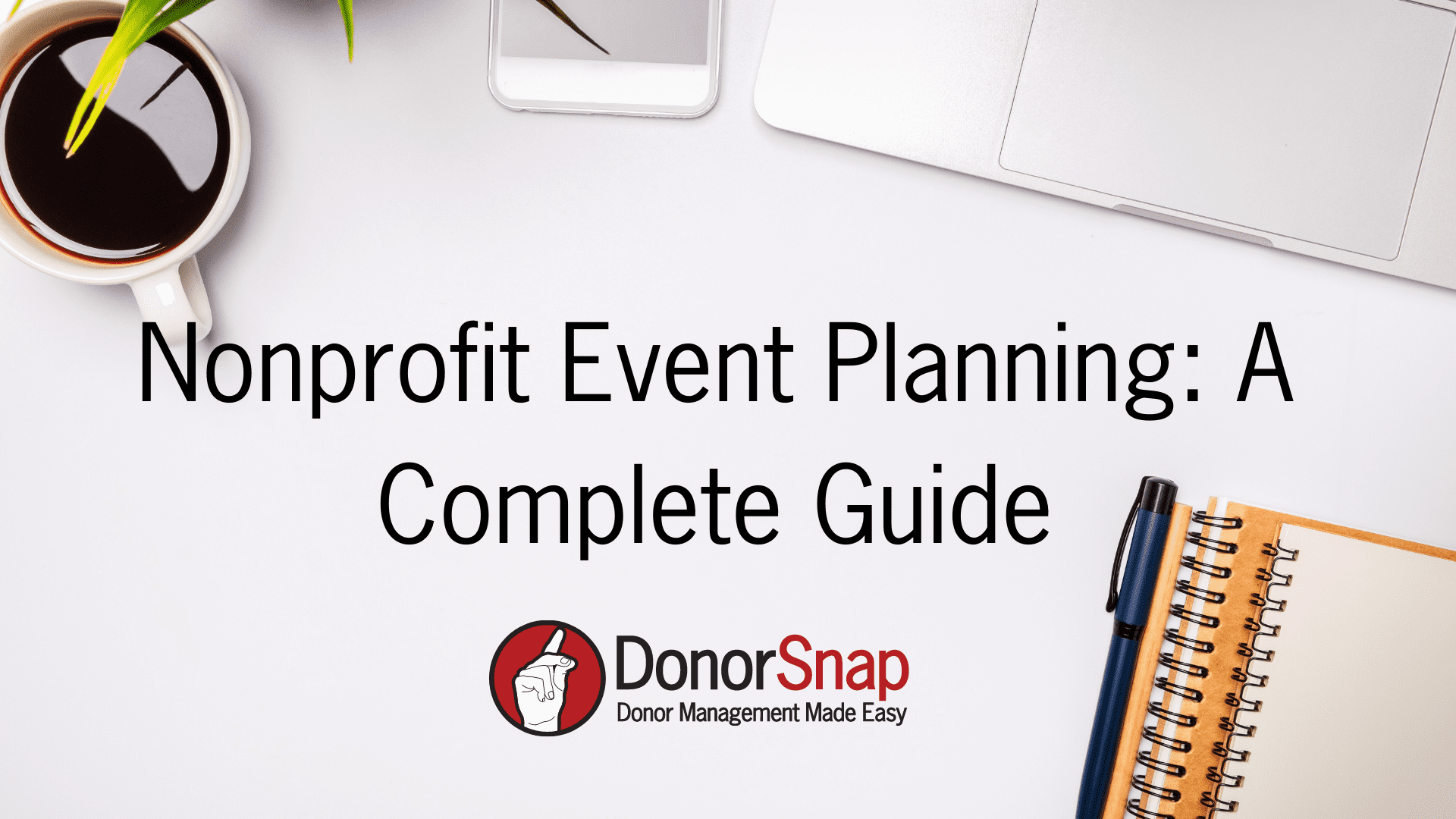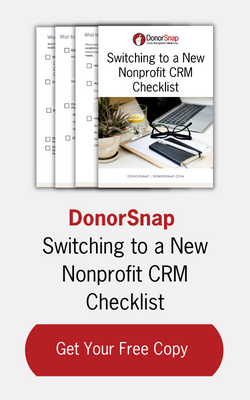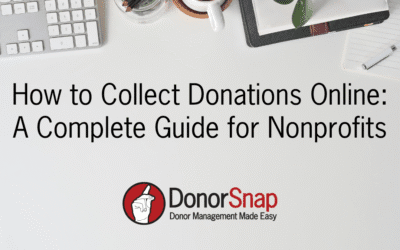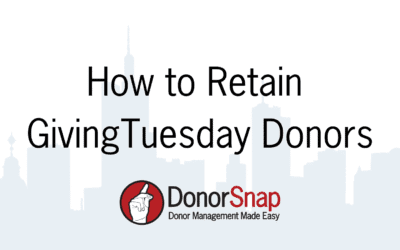Nonprofit events are a great opportunity for organizations to raise money and spread awareness about their cause. Events are also important for donor retention, and can help nonprofits connect with potential new members. If planned properly nonprofits can see a wide variety of benefits from events.
In this guide, discover everything you need to know about planning your next nonprofit event.
What is the Purpose of Nonprofit Events?
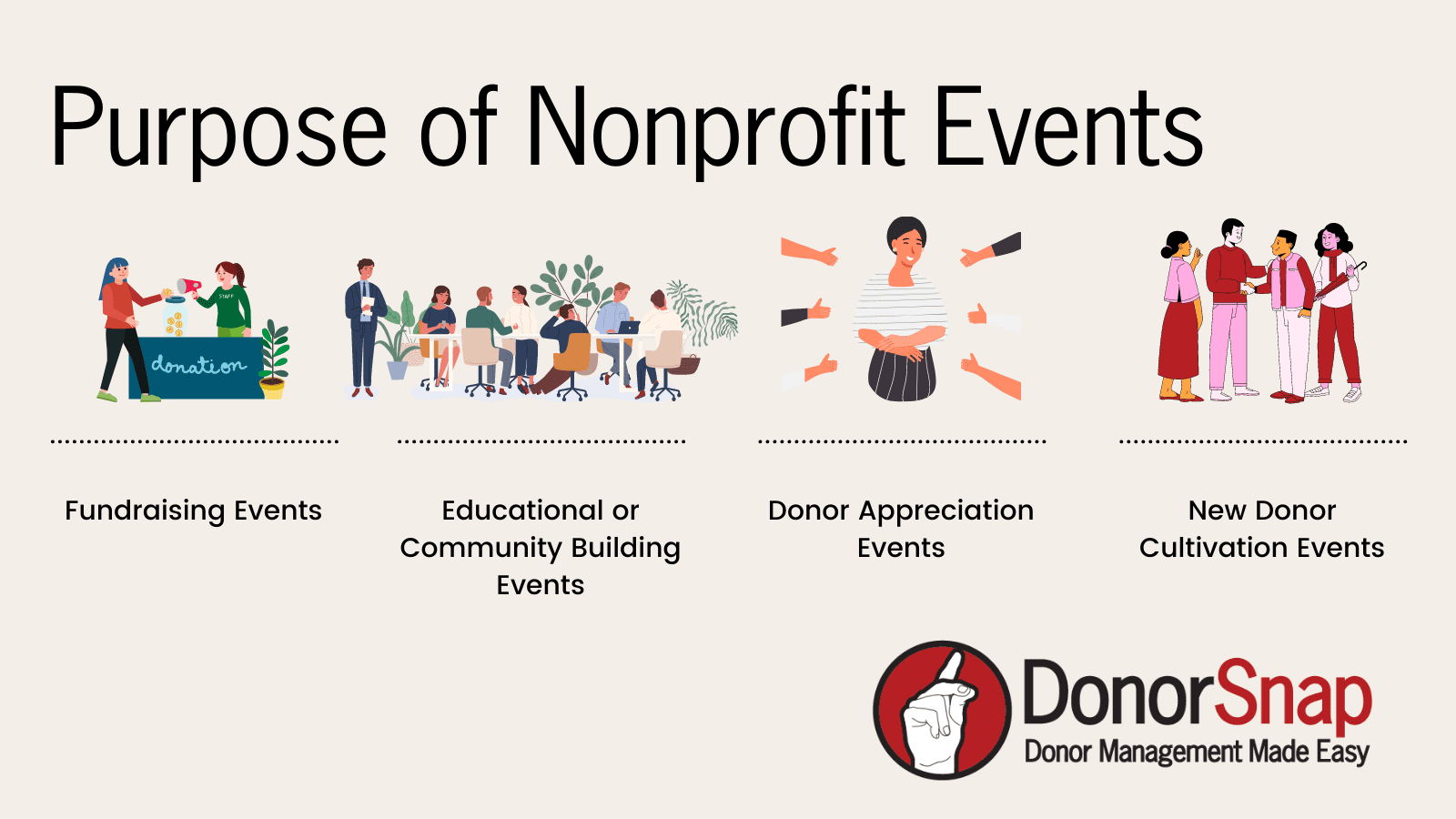
Most nonprofit events serve one or more key purposes: fundraising, education, community building, donor appreciation, or new donor cultivation. Many events combine several of these goals.
Nonprofits host events to connect with donors on a more personal level and to create a sense of community. People often support an organization because they want to engage with others who share their values. Events provide a space for supporters to connect and build meaningful relationships.
What Types of Events are Good for Nonprofits?
Every nonprofit organization is different and will have varying opportunities for events. For example, a nature center might host events like hikes, nature lectures, or bird watching. Likewise, an arts organization may host art shows, performances, or auctions. Depending on the purpose of your event, the type of event you host will vary. Some popular types of events nonprofit organizations host are:
- Galas – Perfect for major donor appreciation with elegant auction components
- Golf Outings – Great for corporate sponsorship opportunities
- Parties – Ideal for community engagement and ticket sales
- Picnics – Family-friendly events with simple registration needs
- Open Houses – Educational events showcasing your mission
- Walks, Runs, or Rides – Fundraising events requiring participant registration
- Fairs or Carnivals – Community events with multiple ticket tiers
- Auctions – High-revenue potential with mobile bidding capabilities
- Lectures or classes – Educational events with limited seating
- Hikes or outdoor activities – Mission-aligned programming
- Art Shows – Perfect venues for silent auctions
- Bake Sales – Simple fundraisers with easy payment processing
- Wine Tastings – Upscale events often featuring live auctions
- Oktoberfest – Community celebrations with food and beverage sales
Pro Tip: Auctions are among the most profitable nonprofit events. Whether you’re hosting a silent auction during a gala or a live auction as the main event, modern mobile bidding technology like AuctionSnap can significantly increase participation and revenue while creating an engaging experience for attendees.
Should You Collect Donations at Your Nonprofit Events?
The purpose and type of your event should guide how you approach in-person giving. If your event focuses on new donor cultivation, some attendees may feel inspired to give on the spot, while others may need additional touchpoints before they’re ready to donate. For fundraising-specific events, it’s completely appropriate to include a clear ask and provide multiple ways to give.
What matters most is making the giving process simple and stress-free, without pressuring your guests. Be prepared with both digital and paper donation options to accommodate different preferences, including credit card, cash, or check.
If you plan to collect donations at your event, DonorSnap Onsite can help. It gives your team access to online forms from any device, allows quick contact lookups, and simplifies in-person data collection and donation processing. It’s a convenient way to manage supporter interactions on the go. Learn more about DonorSnap Onsite here.
Benefits of Well-Planned Nonprofit Events
A successful nonprofit event leaves donors feeling inspired and engaged. Thoughtful planning is essential because while events can be costly, when tailored to the right audience, they create lasting relationships and increase donations. Your events have the potential to retain current donors, attract new supporters, and encourage more people to become champions of your cause.
Modern event management tools can significantly amplify these benefits by streamlining operations, increasing engagement, and maximizing revenue potential—allowing your team to focus on what matters most: connecting with supporters and advancing your mission.
10 Steps to Planning Your Next Nonprofit Event
1. Answer Important Questions to Lay the Groundwork
Every event is unique, so establishing a solid foundation is crucial. This groundwork will drive all subsequent decisions. Here are the most important questions to address when you begin planning:
What is the goal of your nonprofit event?
First, determine whether this is a donor appreciation event, community building event, fundraising event, new donor cultivation event, or a combination. If it’s a fundraising event, set a specific target amount. If you’re hoping to attract new donors, establish a concrete number. Being specific about your goals allows you to easily measure success after the event.
What type of nonprofit event are you hosting?
Next, decide on the event format. For donor appreciation, will it be a gala or intimate dinner party? For community engagement, are you organizing a 5K run? Your event’s goal will determine the most appropriate format. If fundraising is a primary objective, consider incorporating auction elements—silent auctions work well for most event types and can significantly boost revenue.
What is your event budget?
Your budget will influence many decisions, so establish it early in the planning process. Many nonprofits work with limited budgets, but this doesn’t mean you have to sacrifice quality. Local organizations are often willing to donate goods or services. Consider creative partnerships with your community to keep costs manageable.
Once you have a budget, track all expenses meticulously to avoid overspending. Maintain detailed records in a spreadsheet when obtaining vendor quotes. Remember to factor in technology costs—investing in professional event management and auction platforms often pays for itself through increased efficiency and revenue.
Who is invited to your nonprofit event?
Clarify your guest list early. Is it open to the public through ticket sales, or an invite-only donor appreciation event? Are you inviting only major donors, or welcoming all community members? Having a guest count helps with planning and budgeting, while understanding your audience demographics enables you to create an event that resonates with them.
What are the date, time, and location?
Secure these details as soon as possible so you can begin promoting or sending invitations. To maximize attendance, choose your date thoughtfully. Check with key board members or supporters first to ensure their availability.
Coordinate with other nonprofits in your community to avoid scheduling conflicts, as you likely share supporters. When selecting a location, choose somewhere easily accessible to most of your guest list. Also consider technical requirements—ensure your venue has reliable Wi-Fi if you’re planning mobile bidding or digital registration components.
2. Decide on Event Type and Theme
Once you’ve answered the foundational questions, the creative planning begins. With your goals, budget, and purpose established, you can determine your event type and select a theme based on your audience and objectives.
While this step is enjoyable, it should remain strategic. Consider your audience and goals, then design an event that serves both. For example, a thank-you event for community members should be fun, accessible, and cost-effective—perhaps a family picnic in the park. The family-friendly nature will guide decisions about entertainment and food.
Conversely, if you’re hosting a fundraising event to attract millennial donors, your theme should appeal to that demographic. Consider themes that align with your mission while remaining fun and engaging—perhaps a black-and-white cocktail party or 90s-themed dance party.
Theme Considerations for Auction Events: If your event will include auction elements, choose themes that complement bidding activities. Elegant themes like “Casino Night” or “Masquerade Ball” naturally lend themselves to auction excitement, while casual themes work well for silent auctions that run throughout the event.
3. Create Guest Lists and Invitations for Invite-Only Events
With logistics finalized, you can begin inviting guests. Ensure you have confirmed the time, date, location, theme, and activities before sending invitations to provide complete information.
Invite-only events are common for donor appreciation—for instance, an annual event for donors contributing $5,000 or more. Determine your guest criteria and create your list. Pro tip: You can create lists in DonorSnap that automatically update as donor criteria change.
Next, decide on your invitation method. For informal events, send a mass email with RSVP instructions. For formal events, consider printed invitations or online services like Paperless Post. Always have a follow-up plan for non-responders, including phone calls and email reminders as the RSVP deadline approaches.
4. Develop a Promotion Strategy for Ticketed Events
Public events require a different invitation approach. While you’ll still create invitations with complete event details, you’ll share them publicly. Public events typically involve ticket sales, and having the right ticketing system can make or break your event’s success.
EventSnap Integration: For comprehensive ticketing management, EventSnap integrates seamlessly with DonorSnap to streamline your entire event process. EventSnap allows you to:
- Set multiple ticket types and pricing tiers
- Create early bird pricing and discount codes
- Sell event merchandise and upgrades
- Build professional, branded event landing pages
- Process payments securely
- Send automated confirmation emails
- Track attendance in real-time
- Keep all donor data synchronized in one place
This integrated approach eliminates double data entry and ensures every ticket purchaser’s information flows directly into your CRM for future relationship building.
Promotion Best Practices:
To promote your event effectively, create an appealing invitation with all details clearly displayed. Tools like Canva help you design beautiful invitations without design experience. Email the invitation to your entire mailing list, share it on social media platforms, and contact local news outlets. Most local papers happily promote nonprofit events in their coverage area.
Consider creating multiple promotional touchpoints:
- Initial announcement email
- Social media countdown posts
- Partner organization cross-promotion
- Board member and volunteer personal networks
- Local business partnerships
5. Connect with Potential Sponsors
Sponsorships can significantly reduce event costs. Have most details finalized before approaching sponsors so you can think strategically about the best partnerships. For example, if you’re hosting an art auction and dinner, consider partnering with a local custom framing company. Since attendees will be interested in art, they’re an ideal target market for the sponsor. Always ensure sponsors align with your event values.
6. Recruit Volunteers
If volunteers are needed, begin recruiting early. If you have an established volunteer program, reach out to those interested in events. If you’re just starting your volunteer program, check out our guide on building a successful volunteer program. Make tasks specific—ticket collector, donation booth manager, etc. Maintain regular contact with volunteers leading up to the event so they know what to expect. SMS messaging can be particularly effective for volunteer coordination during events.
7. Shop Around for Event Vendors
You’ll need to purchase some services for your event. Once you know what sponsors will provide, start contacting vendors for remaining needs. This typically includes food, entertainment, venue (which should already be secured), and other event-specific requirements.
Start obtaining quotes as early as possible. Inform vendors of your nonprofit status, as many offer discounts. Confirm order deadlines for all vendors to ensure everything is ready for your event day.
8. Develop an Attendee Engagement Plan
Most nonprofit events aim to engage or inspire donors. For success, think strategically about how you’ll connect with attendees to show appreciation or educate them about your cause.
This might include talking points for staff and board members during networking, media such as images, videos, signage, or interactive displays that convey your message, or inspiring speakers and entertainment directly related to your cause.
The possibilities for attendee engagement are endless, but ensure everything aligns with your mission and leaves guests feeling connected and inspired.
9. Send Post-Event Thank You and Follow-Up
The post-event period is critical for connecting with attendees. First and foremost, thank them for attending. This is also an excellent time to recap the evening’s success so they feel excited about their contribution and motivated to participate again.
Send a thank-you email with event photos and statistics about the evening’s impact to keep momentum going. Make this thank-you public by sharing it across social channels. This also reaches people who couldn’t attend, potentially recruiting attendees for next year.
10. Conduct a Post-Event Team Recap
The final step in hosting successful events is an immediate post-event team debrief. Take detailed notes about the evening and discuss what went well and what could be improved. Note volunteer needs—whether you had too many or too few. Record whether you had appropriate quantities of items like food and drinks. These details will help you better prepare for next year.
Always thank your staff and volunteers for their hard work. Nonprofit events require tremendous effort and wouldn’t be possible without their dedication. Provide sincere thanks during your event recap.
Final Thoughts
Nonprofit events are excellent opportunities to thank and engage current donors while attracting new supporters. Thoughtful planning is essential for success, especially given the potential costs involved. Establish your foundation early by setting goals, budget, event type, guest list, location, date, and time.
From there, choose a theme that will attract attendees. With your theme and logistics confirmed, create invitations and begin promotion. Develop a comprehensive plan for engaging event attendees—the goal is for people to leave feeling inspired to give or take action to support your nonprofit.
Finally, post-event follow-up is crucial. Send a recap and thank-you to attendees, and brainstorm with your team about improvements for next year. With proper planning and execution, your nonprofit events can become powerful tools for building lasting relationships and advancing your mission.
